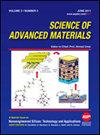Efficacy of Autologous Platelet-Rich Gel Combined with Negative Pressure Drainage in Patients with Diabetic Foot
IF 0.9
4区 材料科学
引用次数: 0
Abstract
Autologous platelet-rich gel (APG) has emerged as a novel treatment modality for diabetic foot, demonstrating potential in promoting wound healing and tissue repair. Negative pressure drainage has been shown to effectively remove wound exudates and facilitate wound healing. The objective of this research was to demonstrate the clinical efficacy of APG combined with negative pressure drainage in patients with diabetic foot. Following the preparation of platelet-rich plasma (PRP) gel, the influence of various temperatures and centrifugation speeds on gel properties was analyzed. PRP was assessed, and the slope and effective disaggregation rate of PRP were compared. A total of 30 healthy volunteers without diabetic foot were recruited as the control group and randomly assigned into three groups, with 10 participants in each group. The mean volume and concentration of PRP in the three groups were analyzed. A total of 30 patients with diabetic foot were selected as the observation group to analyze the therapeutic effects of APG combined with negative pressure drainage in patients with diabetic foot. The results showed that the prepared separated gel effectively isolated components in the blood, with a decrease in gel viscosity observed with increased centrifugation speed and temperature. The pH of the separated plasma remained stable. The plasma showed the best effects when immediately placed. At 0 h, 3 h, and 6 h, the PRP concentration in Group 1 was drastically superior to the other two groups ( P < 0.05). Regarding the slope of PRP, at 30 °C, the slope remained relatively stable; at 25 °C, the slope exhibited the largest variation. At 5 °C, the slope changed between 25 °C and 30 °C. The effective disaggregation rate was lowest when immediately placed, and it gradually increased with the prolongation of placement time. At 30, 60, 90, and 120 minutes of placement, the difference in effective disaggregation rate between 5 °C and 25 °C or 30 °C was considerable ( P < 0.05). The pH of PRP at 0 h, 3 h, and 6 h was weakly acidic, with inconsiderable difference in pH values among the three time periods ( P > 0.05). At 0 h, 3 h, and 6 h, the PRP concentration in Group 1 was markedly superior to the other two groups ( P < 0.05). In summary, the prepared separated gel effectively isolated PRP and the combination of APG with negative pressure drainage demonstrated remarkable therapeutic efficacy in patients with diabetic foot. The adoption of APG provides a personalized and innovative treatment option for diabetic foot patients, offering the potential to improve treatment outcomes.自体富血小板凝胶联合负压引流治疗糖尿病足的疗效观察
自体富血小板凝胶(APG)已成为糖尿病足的一种新的治疗方式,显示出促进伤口愈合和组织修复的潜力。负压引流已被证明能有效清除伤口渗出物,促进伤口愈合。本研究的目的是验证APG联合负压引流治疗糖尿病足的临床疗效。在制备富血小板血浆(PRP)凝胶后,分析了不同温度和离心速度对凝胶性能的影响。评估PRP,比较PRP的斜率和有效分解率。招募30名无糖尿病足的健康志愿者作为对照组,随机分为三组,每组10人。分析三组患者PRP的平均体积和浓度。选择30例糖尿病足患者作为观察组,分析APG联合负压引流对糖尿病足患者的治疗效果。结果表明,制备的分离凝胶能有效分离血液中的成分,且随着离心速度和离心温度的升高,凝胶粘度降低。分离等离子体的pH值保持稳定。等离子体在立即放置时显示出最佳效果。在0 h、3 h和6 h,第1组的PRP浓度显著优于其他两组(P <0.05)。对于PRP的坡度,在30°C时,坡度保持相对稳定;在25℃时,坡度变化最大。在5°C时,斜率在25°C和30°C之间变化。即刻放置时,有效分解率最低,随放置时间的延长,有效分解率逐渐升高。在放置30,60,90和120分钟时,5°C与25°C或30°C之间的有效分解率差异相当大(P <0.05)。PRP在0 h、3 h和6 h的pH值呈弱酸性,三个时间段的pH值差异不显著(P >0.05)。在0 h、3 h和6 h,第1组的PRP浓度明显优于其他两组(P <0.05)。综上所述,制备的分离凝胶有效分离了PRP, APG联合负压引流对糖尿病足患者的治疗效果显著。采用APG为糖尿病足患者提供了个性化和创新的治疗选择,有可能改善治疗结果。
本文章由计算机程序翻译,如有差异,请以英文原文为准。
求助全文
约1分钟内获得全文
求助全文
来源期刊

Science of Advanced Materials
NANOSCIENCE & NANOTECHNOLOGY-MATERIALS SCIENCE, MULTIDISCIPLINARY
自引率
11.10%
发文量
98
审稿时长
4.4 months
 求助内容:
求助内容: 应助结果提醒方式:
应助结果提醒方式:


